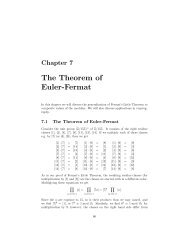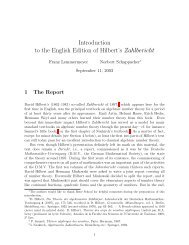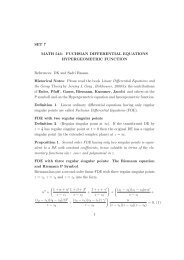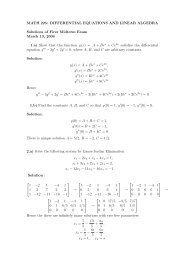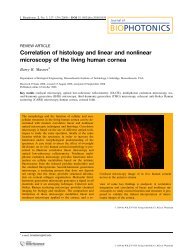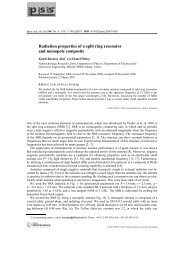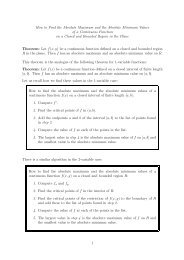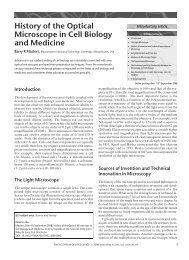Jump processes in surface diffusion - Bilkent University - Faculty of ...
Jump processes in surface diffusion - Bilkent University - Faculty of ...
Jump processes in surface diffusion - Bilkent University - Faculty of ...
You also want an ePaper? Increase the reach of your titles
YUMPU automatically turns print PDFs into web optimized ePapers that Google loves.
52 G. Antczak, G. Ehrlich / Surface Science Reports 62 (2007) 39–61<br />
Fig. 35. Distribution <strong>of</strong> Re adatom displacements at 300 K on W(211), obta<strong>in</strong>ed from field ion observations [115]. Best fit to experiments obta<strong>in</strong>ed with an entirely<br />
negligible contribution from long jumps.<br />
Fig. 36. Displacement distribution for W adatom on W(211) at 307 K [117].<br />
Best fit to field ion experiments derived with negligible contribution <strong>of</strong> β double<br />
or longer jumps.<br />
Fig. 37. Distribution <strong>of</strong> Pd atom displacements on W(211) at 133 K [118]. Best<br />
fit with double/s<strong>in</strong>gle jumps equal to 0.20, and triple/s<strong>in</strong>gle <strong>of</strong> 0.13.<br />
shown <strong>in</strong> Fig. 36 was found to be due entirely to s<strong>in</strong>gle jumps<br />
between nearest-neighbor sites, as expected at the time.<br />
The same was found for the <strong>diffusion</strong> <strong>of</strong> palladium at 114<br />
and 122 K. However, at 133 K, the distribution <strong>in</strong> Fig. 37 for<br />
the first time gave a clear <strong>in</strong>dication <strong>of</strong> significant contributions<br />
from long jumps; the ratio <strong>of</strong> double to s<strong>in</strong>gle jumps was 0.20,<br />
Fig. 38. Distribution <strong>of</strong> Ni adatom displacements on W(211) plane at 179<br />
K [117]. Best fit <strong>of</strong> observations with double/s<strong>in</strong>gle jumps equal to 0.058.<br />
and even triple jumps were detected, at a ratio <strong>of</strong> 0.13 for triple<br />
to s<strong>in</strong>gle transitions. In the <strong>diffusion</strong> <strong>of</strong> nickel atoms on W(211),<br />
Senft [117] found a distribution shown <strong>in</strong> Fig. 38, best fit with<br />
a ratio <strong>of</strong> doubles to s<strong>in</strong>gles <strong>of</strong> 0.058 at T = 179 K. What<br />
was surpris<strong>in</strong>g about these f<strong>in</strong>d<strong>in</strong>gs is not just the detection<br />
<strong>of</strong> long jumps, but long jumps at quite a low temperature, <<br />
0.1T m , and at a rate very temperature sensitive. For palladium,<br />
a dim<strong>in</strong>ution <strong>of</strong> the temperature by 11 K sufficed to elim<strong>in</strong>ate<br />
all long transitions.<br />
With long jumps now firmly established <strong>in</strong> <strong>surface</strong> <strong>diffusion</strong>,<br />
L<strong>in</strong>deroth et al. [119] decided to explore their rates <strong>in</strong> self<strong>diffusion</strong><br />
on the reconstructed Pt(110)-(1 × 2) plane, shown<br />
<strong>in</strong> Fig. 39. <strong>Jump</strong>s were observed with the scann<strong>in</strong>g tunnel<strong>in</strong>g<br />
microscope, which yielded the distribution at 375 K <strong>in</strong> Fig. 40,<br />
with a ratio <strong>of</strong> “double” to s<strong>in</strong>gle jumps <strong>of</strong> 0.095. They also<br />
made measurements over a temperature range <strong>of</strong> 60 K to come<br />
up with the Arrhenius plot <strong>in</strong> Fig. 41, which gave a barrier<br />
<strong>of</strong> 0.81 ± 0.01 eV for s<strong>in</strong>gle jumps and a somewhat higher<br />
value, 0.89 ± 0.06 eV, identified as com<strong>in</strong>g from doubles.<br />
This identification turned out to be premature, however. A year<br />
passed and Montalenti and Ferrando [120] did simulations <strong>of</strong><br />
<strong>diffusion</strong> on Au(110)-(1×2), rely<strong>in</strong>g on RGL <strong>in</strong>teractions [102,<br />
103]. They discovered two prevalent jumps, illustrated <strong>in</strong>



